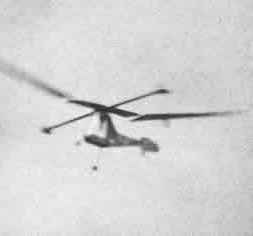|
|
|
|||
|
|
||||
|
|
||||
| Plan: JH-3 Jet Helicopter | ||||
|
|
HOME | SITE MAP | FORUM | CONTACT |
|
||
|
ABOUT | MOTORS | MODELS | ARCHIVE | HISTORY | STORE | FAQ | LINKS
|
|
|
|
|||
|
Whirling Wings by Parnell Schoenky
View or download plan for JH-3 Jet Helicopter Reprinted from Model Airplane News, August 1955, pp. 9, 10, 37-39 A great exponent of radical aircraft, especially helicopters, the author here sums up results of many hundreds of flight tests. |
||||

Perhaps some fresh light on the subject would also prove encouraging to the rather large group of modelers who have never attempted to build a 'copter because they feel that this type is just too complicated, too loaded with hard-to-make parts for anyone but an "expert" to cope with. On the other hand, some of the difficulties which helicopter builders have run into probably seem from over-simplification of the stability and efficiency aspects of such models. What we shall endeavor to get across is that model helicopters are not really difficult, but that they are quite different from ordinary models in the manner in which they obtain life and provide for stability and control. All of us are so familiar with our conventional models that we seldom if ever reflect on the fact that it took centuries for men of genius to bring forth such principles as make possible even the ultra-simple little rubber-powered tractor: the separate stabilizer, negatively inclined, for longitudinal stability; the cambered, dihedraled, high aspect ratio wing; the twisted rubber as a source of power, and the thin-bladed airscrew for converting rubber energy to thrust. To understand the workings of the helicopter, a somewhat more complex flying machine, we shall have to learn the functions of each of its major parts and then discover how they operate in combination. The sea is unforgiving, and the sea of air is doubly so. We cannot blithely assume, as many do, that stability is no problem in 'copter design, simply because every model has a big fuselage hanging below the source of lift like a pendulum. When flight tests begin, the need for positive provisions for inherent dynamic stability is soon brought home to the errant builder. That is, if he hasn't gone astray with regard to the other primary requisite of rotary-wing craft — i.e., efficiency — and failed to get his eggbeater airborne in the first place. Let us deal with this matter of efficiency first of all, for a good understanding of it will do more to put your helicopter into the air than thousands of words on gyroscopes, momentum, and associated theories. (Before we go too far, perhaps it should be noted that space is limited and therefore we won't be able to give detailed explanations for every statement offered.) To begin with, the power helicopter model is considerably less efficient than the average free flight model. For a tough comparison, you can assume that a Class A engine capable of powering a hefty RC ship will only lift a third as much weight when installed on a helicopter. Light construction obviously becomes a must, and this boils down to such practices as the use of light quarter-grained sheet wood for bulkheads, skin, and rotor blades, light wheels, use of the proper gauge wire and metal for fittings, and a minimum of soldered joints. Helicopters require a first rate powerplant, and not simply anything one happens to have in stock. Select your radial-mount engine, either glow-plug or Diesel, for its power-to-weight ratio and not for its torque racing. The average torque-reaction helicopter obtains more lift from its small propeller than from its large rotor. For this reason, the high-torque model, which feeds more of its power into the high-drag, high-inertia main rotor system, is usually out-climbed by the short-stroke, slow-engined ship. Much of the enjoyment to be gotten from flying unorthodox models such as helicopters comes from marching wits with the machine and - in learning how to correct its design faults and how to trim it for desired maneuvers. Proper attention to the weight, life and power problems will insure that your 'copter has the performance to enable it to climb readily and thereby give you the opportunity to observe its stability, gust reactions, and so on. Plenty of deviation from steady, straight climbs or stable translational flight is nothing unusual and does not necessarily mean that any drastic design or trim changes are called for. Individual models differ so widely as to make it impractical to attempt to cover every possible eggbeater aberration in an article of this sort, so we plan to touch on the basic stability problems and let the modeler's common sense take over from there. To get the feel of helicopter flying, we suggest that the modeler first try a model along the simple lines of the XH-5. You will note that the rotor hub engine mount does away with the need for geared transmissions, provides complete accessibility, and allows a flexible coupling to be used between the fuselage and rotor. Several full sized helicopters have used this same idea, and some years ago MODEL AIRPLANE NEWS published a design by Leo Mueller that also employed this torque-reaction principle. To this arrangement Roy Clough, Jr. has added the feathering rotor, and the result is an inherently stable system and one which readily adjusts itself for autorotation after the power cuts. In hovering or climbing flight, the effect of the forces acting on the feathering rotor system is such that the blade tip weights tend to move up into the rotational plane of the blades and hub, with the result that the blades assume a positive pitch angle. When a disturbing force, such as a gust of wind, tilts the rotor assembly, the inertia of the lead weights causes them to change the pitch of the blades momentarily, increasing the pitch on the low side and decreasing it on the high side, and in this way creates a lift differential which serves to right the model. Forward flight, circles, and other forms of translational flight, such as are required of Hiller Competition helicopters, are what put our crafts' stability system to the real test. To induce some forward speed in our model, let us add ballast so as to move the CG forward just a trifle. As soon as we do this, we End that the rotor picks up in efficiency, by reason of the greater volume of air which now passes through the rotor disc in a given time interval. Note that engine power output has not been altered. If the added lift resulting from forward flight should result in an increased rate of climb, we don't mind too much, but if this condition should tend to unload the rotor and thereby allow it to speed up, we may be getting into trouble, for if the rotor speeds up sufficiently, it will lose its capacity to compensate for disturbing forces. The usual result of this situation is a nose-dive. Ordinarily this maneuver isn't a laughing matter, but one of our experimental models made it seem so on one occasion, by nosing over into a small tree where it hung by the main rotor while the engine screamed and sprayed out chopped leaves for a full minute. A great many different forces are acting on the various parts of a helicopter during forward flight and it is not an easy matter to deal with so many variables. Even full scale helicopters tend to be unstable during horizontal movements, so our model problem is not unique. It is probable that most of the difficulty with model 'copters can be traced to fuselage drag; the center of resistance is so far below the CG that forward motion is bound to create a large nose-down moment. For this reason, forward speeds are never great and the permissible rate of motion laterally is so limited as to go undetected where wind drift occurs. The slipstream of the small propeller may exert a torque upon the fuselage of torque-reaction helicopters, depending on the shape and size of the fuselage. Where this torque is present, objectionable spinning of the fuselage occurs during vertical ascent. During forward flight, the fin is able to cancel out this rotational force. The use of a tail rotor to provide a counter-torque is realistic and mechanically simple, but gives rise to weight and structural problems. Fuel seepage past the rotor mast bearing is particularly troublesome. It seems advisable that one ought to start out with the simple, ultra-light fixed fin and tail-boom arrangement such as is used on the XH-5. Spin control is managed by offsetting the fin in the manner indicated on the plans. After the engine cuts, the feathering-rotor 'copter settles promptly into a steady autorotative descent; the rotor continuing to revolve in the same direction as under power. The center of pressure on the blades having moved aft, the pitching moment of the tip weights is overcome and the blades now assume a slight negative angle. Very little, if any, blade twist (for "true pitch") is employed on the rotors of full scale helicopters and none at all is required on the blades of torque-reaction models. For the Jetex helicopters, which derive all of their lift from one large pair of rotor blades, about 6° of wash-out is advisable. Jetex Helicopters Jet helicopters powered by any of the various Jetex solid fuel engines are quite simple to build and fly, and the JH-3 design is no exception. Use of the skewed hinge mounting for the rotor blades, together with separate boom supports for the engines, results in a rotor system that is exceedingly stable under power. When the jet thrust ceases, the kinetic energy of the Jetex engines keeps the rotor turning at a good rate while the blades flap up into autorotative position. In this position the outer portions of the blades are inclined at a slight negative angle relative to the theoretical rotor plane, and rotor rotation becomes self-sustaining. The JH-3 model descends very slowly in autorotation, and is quite capable of doing a little thermal soaring under the proper conditions. With respect to duration, Jetex 'copters naturally cannot compete with gas-engined models, even though the former have superior autorotative qualities. Where the heavy, multi-charge engines such as the "350" are used, motor runs can be as much as 24 to 36 seconds. Only moderate rates of climb. are possible with the "350" and its smaller companion unit, the "200". The Jetmaster "150" or the powerful new Scorpion "600" should be used where snappy performance is required. To keep down rotor vibration, al- ways light both Jetex fuses simultaneously. |

- Model Airplane News, Aug. 1955, p. 10
|
|||
|
|
|
|||
|
|
|
|
|
|
|
|
Acknowledgements Article source: - Toronto Aerospace Museum via Bill Henderson |
|
|
|
|
ABOUT | MOTORS | MODELS | ARCHIVE | HISTORY | STORE | FAQ | LINKS |
|
|
Terms of Use
|
Queries? Corrections? Additions?
Please
contact us.
|
|